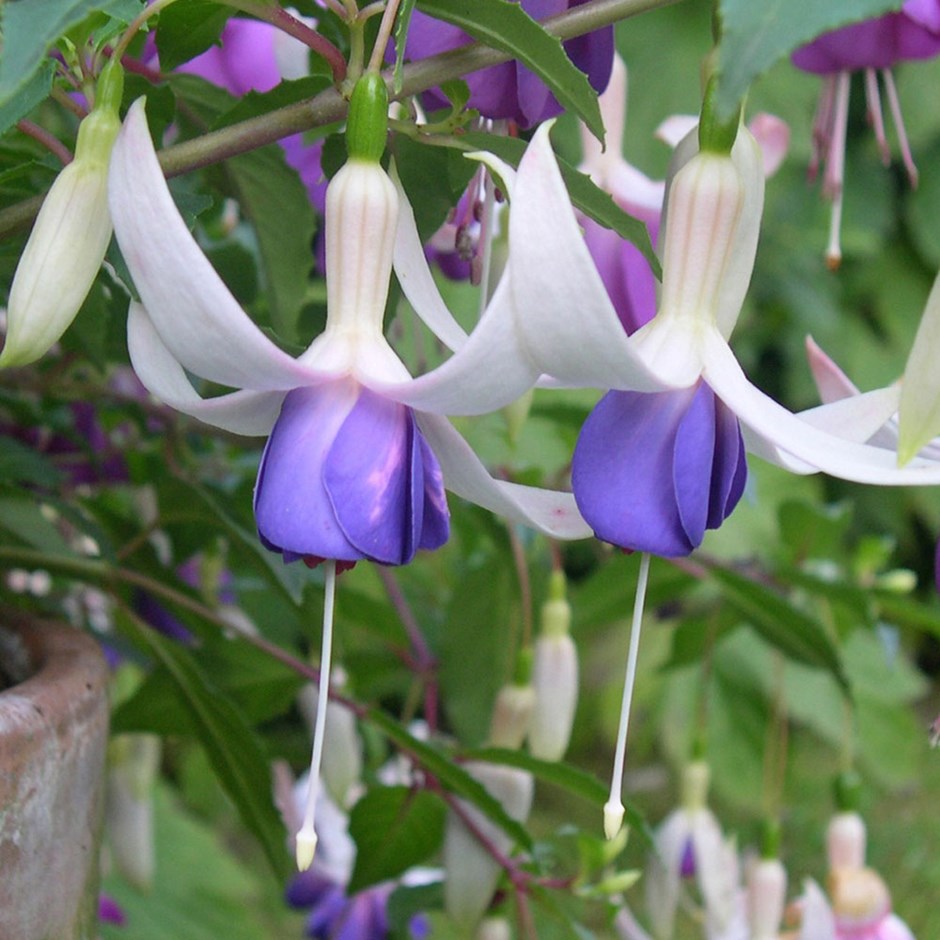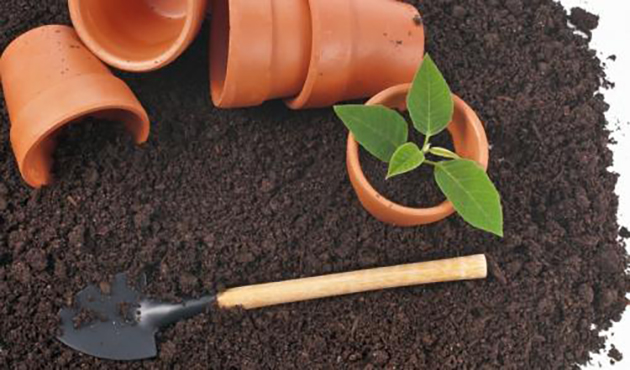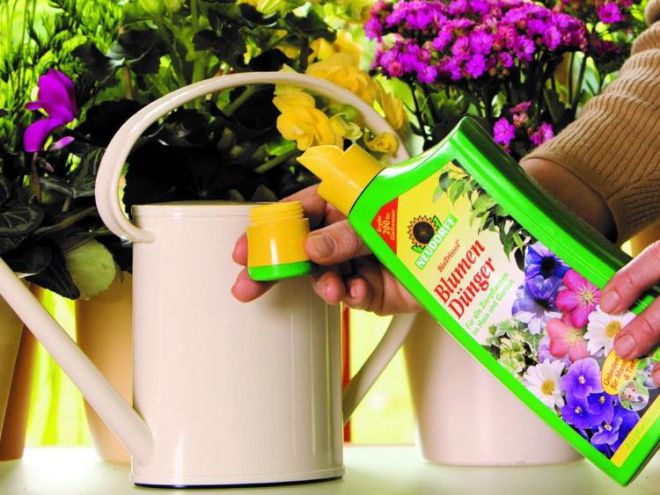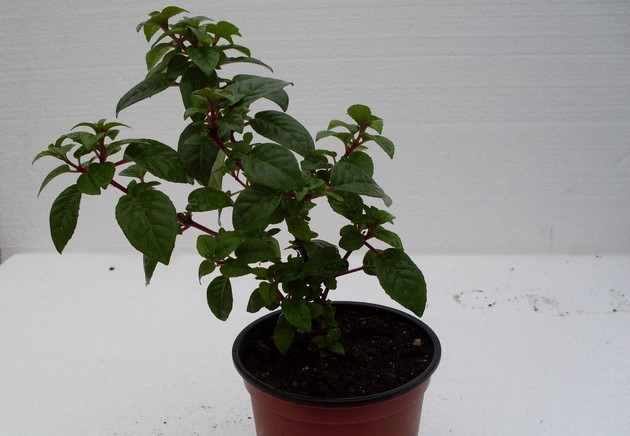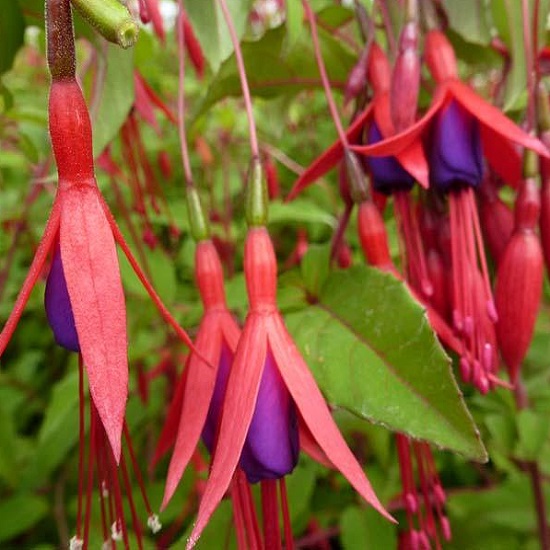Even in the seventeenth century, this exotic beauty was used to decorate the rooms and windows of houses. Over the past centuries, more than 100 varieties have been bred by breeders. But the plant gained particular popularity when hybrid fuchsia appeared, growing and caring for it in the garden is within the power of everyone.
Garden fuchsia
For outdoor cultivation, hybrid varieties are chosen: erect bushes with large flowering or ampelous fuchsia with medium / small flowers. The latter are most suitable for planting in pots, pots or flowerpots.
Hybrid varieties suitable for a summer cottage or garden can be divided into groups:
- Sapphire. In bloom, two colors are combined: white and blue, which ranges from light blue to bright purple (the most popular varieties are Capri and Ultramarine).
- Australian. Tall bushes with large flowers (Matilda, Valsing).
- Terry - small bushes with medium-sized double flowers (Sarah Jane, Florentina)
- Ampelnye (the most famous are Cascade and Alice Ashton).
Fuchsia bush is an exotic perennial. She will feel great in a corner of the site, where strong winds will not disturb her. There should be enough light in the morning, the rest of the time the flower tree needs shade. This beauty loves neutral fertile soils.
For the winter, the plant is dug up and stored in a cool room.
Flower reproduction methods
In order for the fuchsia to bloom throughout the summer period, proper care and reproduction of this plant is important. Bushes obtained by cuttings reach the flowering period much faster than young seedlings.
There are two ways to breed fuchsia:
- Vegetative (grafting). This method of breeding is the most popular, the plants grown in this way are much easier to care for and begin to bloom faster. Cut a bush every three years to update it. Dense woody shoots, on which at least two healthy buds are visible, are cut off, placed in water or a liquid substrate with sand. After 1-2 weeks, roots appear. Next, the new plant is transplanted into a pot. In the spring, old shoots are removed, replacing them with new ones.
- Planting with seeds. The main thing in this method is to buy fresh seeds. Planting is carried out in mid-February in order to move the seedlings into open ground in early May. The ideal way to grow seedlings at home is with peat tablets, which are then buried in the ground along with the plant. This method allows you not to damage the roots of a young plant.
The soil for fuchsia in a pot or container should be light, neutral and nutritious. You can make it yourself: mix 3 parts of sod land, 2 parts of decomposed peat and 1 part of sand.
The container for planting must necessarily have drainage holes. First, expanded clay is poured into the box so that water does not stagnate in the soil, otherwise the roots will begin to rot, and the seedlings will die. Next, the soil is laid in a dense layer, its surface should be 2-3 centimeters below the edge of the box.
The seeds are planted to a depth of 3-4 centimeters, the sowing is watered, the container is closed with polyethylene, making sure to leave a hole for air circulation. The container should be placed on a warm windowsill, out of direct hot sunlight. The optimum room temperature for germination is 22 degrees. Watering should only be done when the ground surface is dry, with a little water, avoiding high soil moisture. After the emergence of shoots, they are watered drip under the root 1 time in 2 days, the air is humidified daily in a box from a spray bottle.
Seedlings are transplanted into open ground in early May. The land for fuchsia in its composition must necessarily contain drainage. When planting, it is important to ensure that the root collar is not deepened by more than 20 centimeters. After 2-3 weeks, with proper care, the young plant will adapt and grow.
Many experienced flower growers plant a fuchsia tree in the open ground with a pot in spring. Thus, you can water the flower less often, and with the arrival of autumn it is easier to dig it up.
Summer care
If you carefully study what conditions fuchsia prefers, growing and caring in the open field will not be a problem.
Many novice florists are interested in how to water fuchsia, because it belongs to tropical plants. It is important to constantly maintain normal soil moisture, while avoiding waterlogging. In too wet soil, the roots of the plant will begin to rot.
If the fuchsia does not have enough moisture, the leaves will droop and may even fall off. So at the first sign of drooping foliage, you should immediately moisten the soil.
The plant is usually watered in the morning with settled water, after watering, the soil is loosened, removing weeds. In the evening, you should arrange a warm shower for a flowering tree.
Once every 2-3 weeks, the plant should be fertilized, alternating root feeding with foliar. Of organic fertilizers for fuchsia, mullein or humus of low concentration, as well as wood ash, are useful.
For the lush flowering of street fuchsia, potassium and phosphorus are needed when planting and leaving. Therefore, fertilizers containing these elements should be used. Usually, during the budding period, liquid instant fertilizers for flowering plants are used weekly, which are bred according to the instructions. For example, drugs:
- Kemir,
- Plantafol,
- Kristalon.
You can also fertilize the tree with biohumus, nitrogen or mineral fertilizers. With proper care, fuchsia begins to bloom three weeks after transplanting into open ground and pleases the eye with the beauty of its inflorescences throughout the summer. Excellent neighbors in a flower bed for a plant are begonia, balsam and ivy.
In addition to watering and fertilizers, temperature conditions are important for fuchsia. Even in summer, the ambient air temperature should not exceed 22 degrees. If the temperature is higher, the plant needs to be watered abundantly, as well as spray the leaves and flowers with a spray bottle every evening.
If fuchsia does not bloom, the cause of this phenomenon may be:
- lack of light;
- low ambient temperature;
- overfeeding the plant with nitrogen fertilizers.
After eliminating the cause, the non-flowering fuchsia should be trimmed, removing long stiff shoots. If all the conditions are met, young branches will begin to develop in the bush and buds will definitely appear.
Preparing for winter
An annual fuchsia must endure frost before wintering in order to harden.
Usually fuchsia is dug up in winter, since even in central Russia, the plant rarely survives the winter and freezes over. Before digging up this exotic beauty, the tree is cut in half. Place the pot with pruning in a bright room with a temperature of 6-12 degrees and watered once a week.After the leaves fall off, it can be placed in a dark room and watered once a month.
With the arrival of spring, fuchsia is taken out again to a bright room and begins to be fertilized once every 2 weeks with nitrogen-phosphorus fertilizers so that it wakes up.
Fuchsia Magellan can winter outdoors in the street. For this, the plant is completely sheared, buried in the ground by 20 cm, and covered with spruce branches from above. Open only in mid-May. True, with this method, the bush will begin to bloom only in August.
It is always quite difficult to grow an exotic plant with your own hands at home. Even having thoroughly studied what fuchsia loves and how to care for it, not everyone decides to purchase it, preferring more unpretentious plants. But those flower growers who learn to care for this beauty will receive aesthetic pleasure and pride in their beautiful garden.
